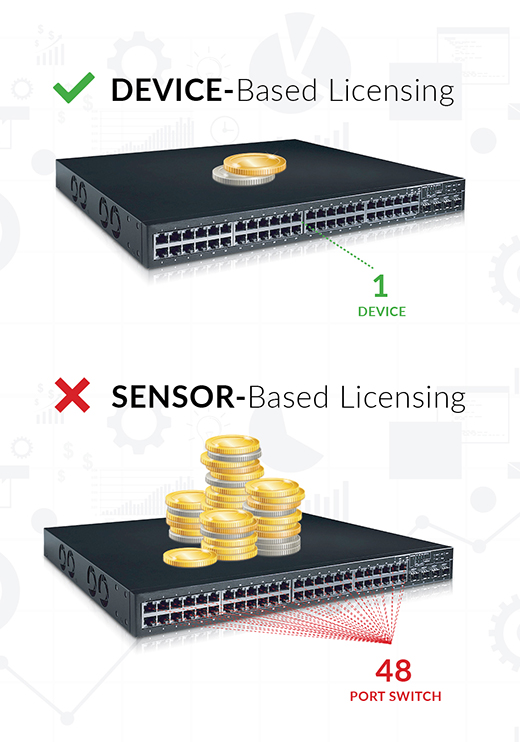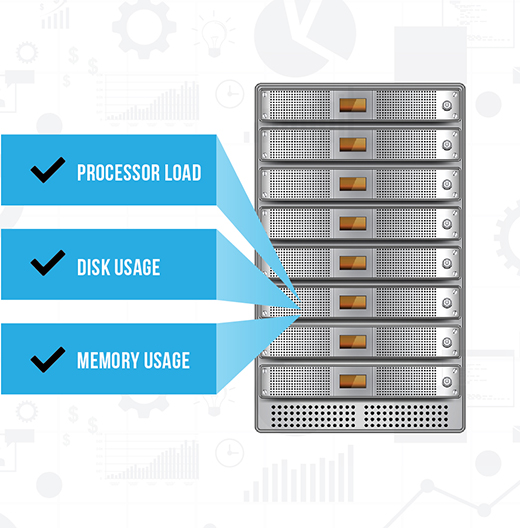
It's no secret that IT teams are budget-strapped. You want to get your money’s worth when you spend money on software. But with every vendor offering different licensing plans, comparing them to figure out who delivers the most value is hard.
Several of our competitors offer sensor-based licensing. They say that this is the “most fair” model.
When evaluating the price of software like Intermapper, these three things are probably important to you:
- A simple licensing model that makes it easy to budget for the future.
- The ability to monitor multiple elements per device without skyrocketing costs.
- Total cost of ownership that’s not just affordable today, but years from now.
Sensor-based licensing doesn’t meet these three requirements. But Intermapper’s device-based licensing does. Keep reading to find out why.
1. A simple licensing model

How does sensor-based licensing work?
A sensor is a basic monitoring element of a device, such as memory utilization, CPU load on a machine, traffic on a switch port, or free space of a disk drive. In a sensor-based licensing model, you pay for each sensor.
Let’s say you have a 48-port switch. If you want to monitor all 48 ports, with sensor-based licensing you’ll need at least 48 licenses, or maybe even more.
What are the pros and cons?
While sensor-based licensing helps you monitor everything, you’ll eat up your licenses fast if you want to monitor a lot of device elements. Also, if your network changes often, it can be hard to predict future license costs. You may find that you’re constantly buying more. Finally, with sensor-based licensing, you pay per sensor, but Intermapper offers free built-in probes that give you the same granular monitoring abilities. (More on that in #2.)
How does Intermapper licensing work?
Intermapper is licensed by device. A device is any machine in your network, like routers, switches, firewalls, workstations, mobile or wireless devices, or servers. In a device-based licensing model, you pay for each device you want to monitor. If you want to monitor interface traffic on a switch, with sensor-based licensing you will need a sensor for every interface you want to monitor.
What are the pros and cons of the two licensing models?
Device-based licensing is usually the most cost-effective because the more aspects of a device that you want to monitor, the more value you get. You won’t pay extra. Also, as devices grow, your costs remain steady. And maintaining your licenses are easy, since you probably won’t need to add device licenses as often as you would have to add sensors. And when you do, it’s straightforward and simple.
Related Content: Take the Confusion out of Network Monitoring Software Licensing Models
2. The ability to monitor multiple things per device

Most IT operators would love to monitor more than one thing per device. You want to know if a certain URL is up and running, or what the network traffic is for a certain connection. Which of the following scenarios is true for you?
- You have servers with multiple applications and protocols running on them that you want to monitor.
- Your switches have multiple ports that you want to monitor.
- You just want to be able to monitor availability on a device.
But if your software is licensed by sensor, monitoring more than one thing per device will make your costs balloon out of control. The more you monitor, the more you pay.
With intermapper, the more you monitor, the more you save. Intermapper lets you monitor multiple aspects of a device without paying extra. You can use Intermapper to capture as much information as possible for free through Intermapper probes (software plug-ins that capture specific device metrics and report back). Intermapper offers hundreds of probes, either built-in to the product or through our user community.
Let’s say you want to monitor all these metrics on a device:
- Processor load
- Disk usage
- Memory usage
- One-minute load time
- Five-minute load time
- Fifteen-minute load time
With a sensor-based solution, you’d probably need multiple sensors to monitor all those things. And you’d pay for each sensor. But with Intermapper, you can monitor these aspects with one probe—our SNMP Host Resources Probe.
And it’s free!
3. An affordable total cost of ownership
When you buy network monitoring software, you are not just thinking about the initial cost. You’re calculating a couple years out to determine your total cost of ownership.
Most network monitoring solutions do these two things:
- Charge an initial perpetual license fee.
- Charge extra for annual support.
Here’s where solutions with device-based licensing offer more value:
Cost escalation: Over time, sensor-based monitoring costs will grow quickly as you monitor more device aspects. By contrast, Intermapper pricing remains steady as you add more devices.
Subscription pricing: Subscription licensing offers benefits like easy shared access, cost predictability, and faster time to value. Not all sensor-based solutions offer subscription pricing, but Intermapper does give you this option.
So… who wins?
If you’re trying to evaluate whether a device-based or sensor-based solution is more affordable, your final cost will depend on what you plan to monitor.
The more you monitor, the more you save with intermapper. Go with Intermapper if:
- You want a simple licensing plan that is easy to predict and maintain.
- You plan to monitor multiple components for each of your devices.
Example #1: Monitoring an Exchange Server
Let’s say you want to monitor an exchange server. You want to monitor it holistically, which means monitoring all the following elements:
- Ping
- CPU
- Disk Storage
- RAM Memory
- CPU Processor Load (2 Processors)
- NIC Card Traffic (2 Network Interfaces)
- Exchange Mailbox Server (Mailbox Send and Receive Queues)
With sensor-based licensing, you will need at least 10 sensors to monitor all those elements on one device.
With Intermapper, you only need one license to monitor the actual server, and then you can use free probes to monitor all the individual elements, since probes are flexible to allow you to monitor multiple items per probe. In this case you’d need four probes: a ping probe, a host resource probe, an SNMP traffic probe, and an Exchange Mailbox probe.
Example #2: Monitoring the Network in an Educational Setting
You have a roughly 450-device school that you want to monitor. Each of your switches has 48 ports you want to monitor, and for all your devices, you have about 10 different metrics that you want to keep tabs on.
When you calculate it out, you realize that with sensor-based software, you’ll need close to 5,000 sensors to monitor all of this.
| Equipment | Monitored Elements | Devices | Sensors |
|---|---|---|---|
| Routers | 10 elements per device | 10 | 100 |
| Switches | 48 ports per switch | 4 | 192 |
| Firewalls | 10 elements per device | 2 | 20 |
| Wireless access points | 10 elements per device | 50 | 500 |
| Desktop PCs | 10 elements per device | 125 | 1250 |
| Mobile devices | 10 elements per device | 250 | 2500 |
| Printers | 10 elements per device | 10 | 100 |
| TOTAL | 451 | 4662 |
But you realize that Intermapper’s device-based licensing will give you just as much monitoring for half the price.
| Perpetual License | Year 1 Support | Year 2 Support | TOTAL | |
|---|---|---|---|---|
| Intermapper | $4,275 | $855 | $881 | $6,011 |
| Sensor-Based Competitor | $10,500 | Included | $2,625 | $13,125 |
When you want more for your monitoring, Intermapper can monitor more. Paying per device keeps your costs low, and probes give you the ability to monitor as many metrics as you want per device, without paying extra.